MICORM 450 Final
0.0(0)
0.0(0)
Card Sorting
1/126
Earn XP
Description and Tags
Study Analytics
Name | Mastery | Learn | Test | Matching | Spaced |
|---|
No study sessions yet.
127 Terms
1
New cards
Orthomyxoviridae
Influenza virus
* ortho - “true
* myxo = “mucus”
* 7 genera, 9 species
* ortho - “true
* myxo = “mucus”
* 7 genera, 9 species
2
New cards
Human influenza viruses
Influenza A-D viruses
* Sialic acid attaches to galactose via alpha**(2,6)**linkage
* **upper** respiratory infection
* Sialic acid attaches to galactose via alpha**(2,6)**linkage
* **upper** respiratory infection
3
New cards
Avian influenza viruses
* Sialic acid attaches to galactose via alpha**(2,3)**linkage
* **lower** respiratory infection
* **lower** respiratory infection
4
New cards
Subtypes of Influenza are named by…
Antigenicity of hemagglutinin (HA) and neuraminidase (NA)
* There are 18HA and 11NA
* There are 18HA and 11NA
5
New cards
Hemagglutinin (HA)
Surface glycoprotein, binds sialic acid receptor, fusion protein
* Key in entry, uncoating, and nuclear import
* Key in entry, uncoating, and nuclear import
6
New cards
Neuraminidase (NA)
Surface glycoprotein for influenza viruses
7
New cards
Virus Taxonomy Label
Virus Type / Place Isolated / Strain # / Year Isolated / Virus Subtype
8
New cards
Influenza Virus Structure
* Enveloped (spherical/filamentous)
* HA:NA = 10:1
* RNA poly, ion channel, matrix protein, nuclear export protein, nucleocapsid protein
* HA:NA = 10:1
* RNA poly, ion channel, matrix protein, nuclear export protein, nucleocapsid protein
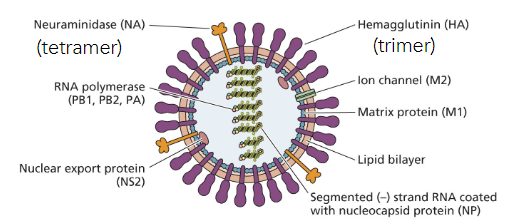
9
New cards
Influenza Virus Genome
Segmented, Negative-sense RNA virus
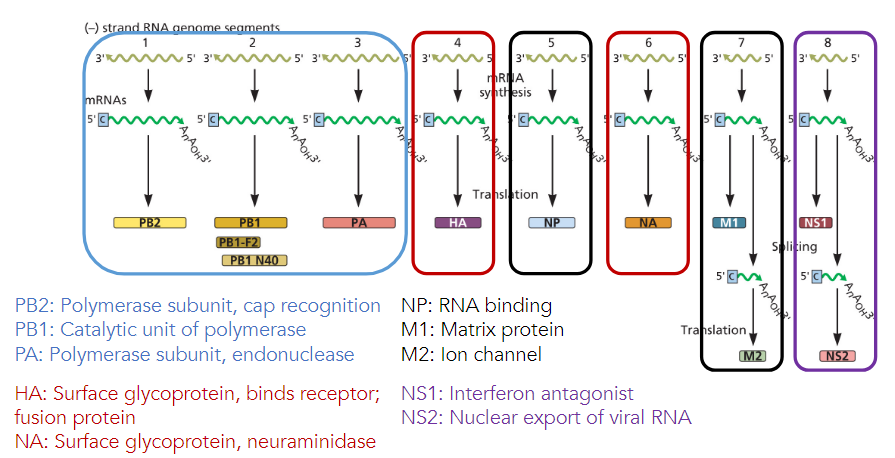
10
New cards
Uncoating of Influenza Viruses
* M2 (ion channel) pumps H+ virion
* pH = 5.0 induces conformational change of HA that exposes fusion peptide that inserts into endosomal membrane (fusion) and releases into cytoplasm for nuclear import
* pH = 5.0 induces conformational change of HA that exposes fusion peptide that inserts into endosomal membrane (fusion) and releases into cytoplasm for nuclear import

11
New cards
Replication of Influenza Viruses
* mRNA synthesis for viral protein translation & genome replication for viral progeny occur in nucleus
* polymerase is a cap-dependent RNA endonuclease
* 5’ end held by PB1 forms polyA tail stutter
* polymerase is a cap-dependent RNA endonuclease
* 5’ end held by PB1 forms polyA tail stutter
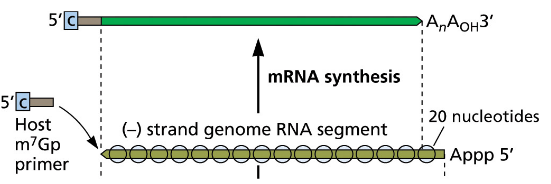
12
New cards
Cap Snatching
Initiation of viral mRNA synthesis (transcription); first 10-20 residues of a host cell RNA are removed and used as the 5′ cap and primer to initiate the synthesis of the new viral mRNA
* Inhibits cellular mRNA expression and masks viral RNAs from PRRs
* PB2 responsible for cap recognition
* Inhibits cellular mRNA expression and masks viral RNAs from PRRs
* PB2 responsible for cap recognition
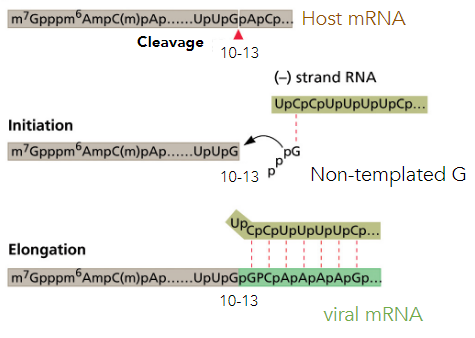
13
New cards
Overview of Viral mRNA Synthesis (influenzas virus)
Primary transcription
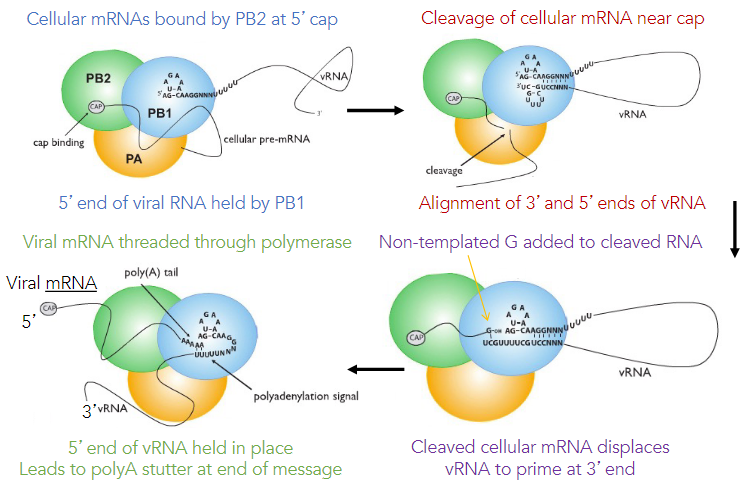
14
New cards
Influenza virus nucleoprotein (NP)
Switches influenza virus RNA synthesis from transcription mode to **replication** mode
* Amount of NP dictates switch from mRNA to cRNA (secondary transcription)
* Free NP binding to 5’ end of vRNA causes initiation of cRNA (anti-genome)
* Cap-**independent** RNA synthesis
* Amount of NP dictates switch from mRNA to cRNA (secondary transcription)
* Free NP binding to 5’ end of vRNA causes initiation of cRNA (anti-genome)
* Cap-**independent** RNA synthesis
15
New cards
Assembly of Influenza Viruses
* Occurs in cytoplasm
* HA & NA translated via ER-associated ribosomes
* ER-golgi localizes HA & NA to plasma membrane
* Genomic segments bound to viral RNP undergo selective packaging and reassortment
* HA & NA translated via ER-associated ribosomes
* ER-golgi localizes HA & NA to plasma membrane
* Genomic segments bound to viral RNP undergo selective packaging and reassortment
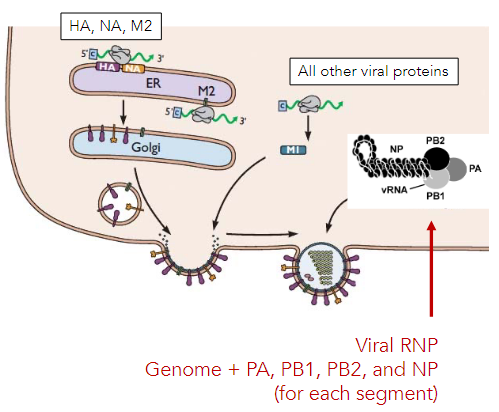
16
New cards
Maturation & Egress of Influenza Viruses
Maturation
* Host proteases mature HA to fusogenic state
Egress
* NA cleaves sialic acid to release progeny from surface
* Host proteases mature HA to fusogenic state
Egress
* NA cleaves sialic acid to release progeny from surface
17
New cards
Transmission of Influenza Viruses
* Acute (peak 2 days post-infection and shed after about a week)
* Caused by direct contact (individual/contaminated objects) & inhalation of virus-containing airborne particles
* Typically more severe in young and old (immature/waning immunity)
* Caused by direct contact (individual/contaminated objects) & inhalation of virus-containing airborne particles
* Typically more severe in young and old (immature/waning immunity)
18
New cards
Pathogenesis of Influenza Viruses
* Infects airway epithelia and alveolar macrophages
* Disease due to inflammation via cytokine storm (flu-like), lung-damage
* Does not cause pandemics BUT seasonal (Dec-Feb) due to contact and minimum humidity
* Disease due to inflammation via cytokine storm (flu-like), lung-damage
* Does not cause pandemics BUT seasonal (Dec-Feb) due to contact and minimum humidity
19
New cards
Influenza Virus Vaccines
Inactivated and Live-Attenuated
* Inactivated made in chicken eggs; Quadrivalent; Targeting HA stalk
* Inactivated made in chicken eggs; Quadrivalent; Targeting HA stalk
20
New cards
Natural Reservoirs & Cross-Species Transmission of Influenza Viruses
* Epidemiology involves close contact of humans, domesticated animals
* Wild birds are **reservoir host** of __all__ influenza subtypes
* Intermediate hosts (ex: chicken) increase replication and transmission in humans
* Wild birds are **reservoir host** of __all__ influenza subtypes
* Intermediate hosts (ex: chicken) increase replication and transmission in humans
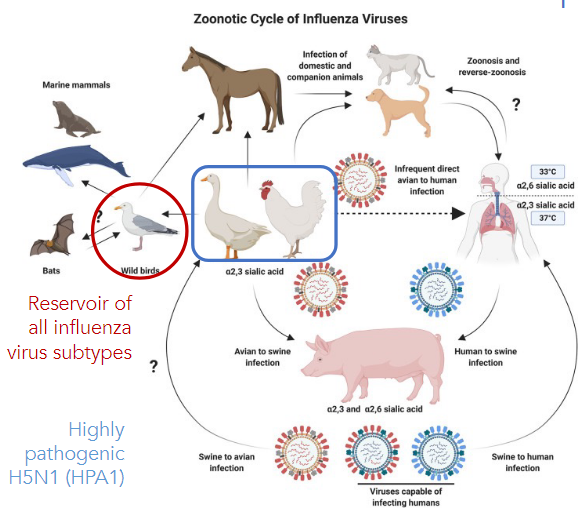
21
New cards
H5N1 Influenza Virus
Highly pathogenic
* Has high fatality rate w/ little human-human spread
* Has high fatality rate w/ little human-human spread
22
New cards
Antigenic **Drift** of Influenza Viruses
Point mutations in HA & NA in human variants
* Annual epidemics
* Cross-protection
* Selection for escape from neutralizing antibodies
* Annual epidemics
* Cross-protection
* Selection for escape from neutralizing antibodies
23
New cards
Antigenic **Shift** of Influenza Viruses
Reassortment of new HA and/or NA segments from non-human strains
* Typically avian
* Global pandemic
* Little cross-protection
* Typically avian
* Global pandemic
* Little cross-protection
24
New cards
Reassortment
Viral ’progeny’ that inherit segments from distinct ‘parents’ are called reassortants
* A cell can be ‘superinfected’ with 2 different influenza viruses; Genome of both viruses are made
* large genetic shifts (can causes influenza pandemics)
* EX: Avian + Human virus led to swine flu (H1N1)
* A cell can be ‘superinfected’ with 2 different influenza viruses; Genome of both viruses are made
* large genetic shifts (can causes influenza pandemics)
* EX: Avian + Human virus led to swine flu (H1N1)
25
New cards
Human influenza virus evolution is largely driven by…
immune (antibody) escape in HA and NA
26
New cards
Original Antigenic Sin
the development of immunity against pathogens (antigens) is shaped by the first \n exposure to a related antigen
* People born before 1957 had memory against a very similar H1 (1918 H1N1)
* People born in 1957 had memory against H2N2 (non-protective, and maybe enhanced susceptibility)
* People born before 1957 had memory against a very similar H1 (1918 H1N1)
* People born in 1957 had memory against H2N2 (non-protective, and maybe enhanced susceptibility)
27
New cards
Structure of Flavivirus
* 50um viral particles
* Icosahedral
* Decorated w/ envelope (E) and membrane protein (M)
* Icosahedral
* Decorated w/ envelope (E) and membrane protein (M)
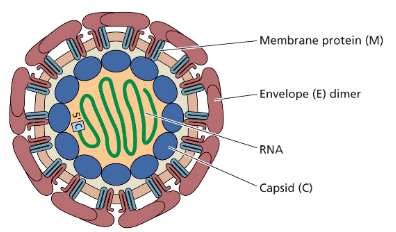
28
New cards
Flavivirus Genome
Enveloped positive-sense RNA virus
* 5’cap, 5’-UTR, single ORF, 3’-UTR
* UTRs contain RNA secondary structures that mediate long range 5’ and 3’ RNA interactions
* 5’cap, 5’-UTR, single ORF, 3’-UTR
* UTRs contain RNA secondary structures that mediate long range 5’ and 3’ RNA interactions
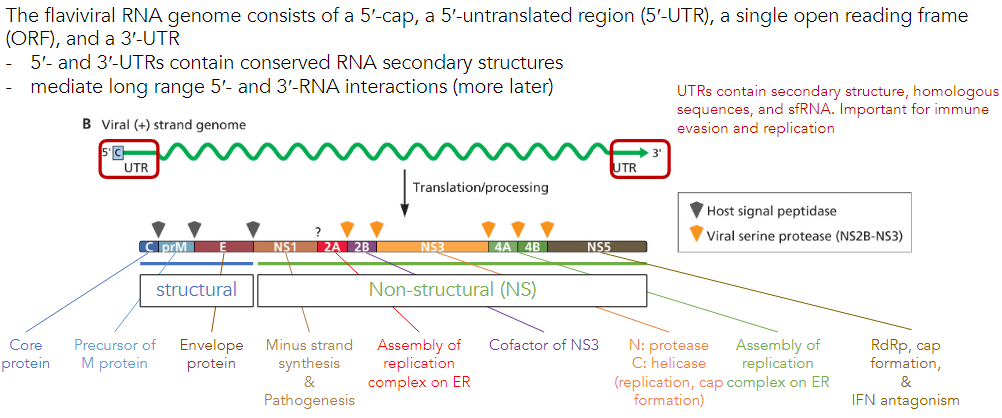
29
New cards
Attachment of Flaviviruses
Attachment factors that do NOT induce conformational changes for fusion/uncoating
* Bind via Asp-linked sugars w/ C-type lectins interaction (DC-SIGN)
* Ptd-Ser (PS) interacts w/ host PS receptors (TIMs, TAMs)
* Bind via Asp-linked sugars w/ C-type lectins interaction (DC-SIGN)
* Ptd-Ser (PS) interacts w/ host PS receptors (TIMs, TAMs)
30
New cards
Fusion & Uncoating of Flaviviruses
* Receptor-mediated endocytosis
* Endocytic vesicle acidification induces conformational change in E
* Activated E fuses w/ endosome membrane to release genomic RNA into cytoplasm
* Endocytic vesicle acidification induces conformational change in E
* Activated E fuses w/ endosome membrane to release genomic RNA into cytoplasm
31
New cards
Translation of Flaviviruses
* Translation occurs in ER-ribosomes
* Translated into single viral polyprotein
* Host and virus encoded proteases used to cleave viral protein (NS2B-NS3)
* Translated into single viral polyprotein
* Host and virus encoded proteases used to cleave viral protein (NS2B-NS3)
32
New cards
Replication of Flaviviruses
* Asymmetric replication and assembly occur in ER-viral factories
* (-) strand synthesis via 5’ and 3’ UTRs to create dsRNA using NS5 RdRp
* (-) strand in dsRNA used to make many copies of (+) strands
* 5’ cap via NS3 and NS5
* (-) strand synthesis via 5’ and 3’ UTRs to create dsRNA using NS5 RdRp
* (-) strand in dsRNA used to make many copies of (+) strands
* 5’ cap via NS3 and NS5
33
New cards
Assembly of Flaviviruses
1. viral RNA captured by NS2A and transported to assembly sites
1. NS2A recruits unprocessed C-prm-E and NS2B
2. NS2B3 cleaves C-prM-E polyprotein
3. C proteins bind genomic RNA from NS2A to form nucleocapsid
4. prM/E proteins form trimeric spikes on luminal side of membrane
5. Virion **buds** out of ER lumen
1. non-infectious; prM (chaperone) prevents premature fusion and inactivation during egress (60 heterotrimeric spikes)
6. In golgi, E proteins undergo pH-dependent conformational change
1. Furin cleaves prM and mature virus forms (herringbone)
2. 90 E dimers lie flat against membrane
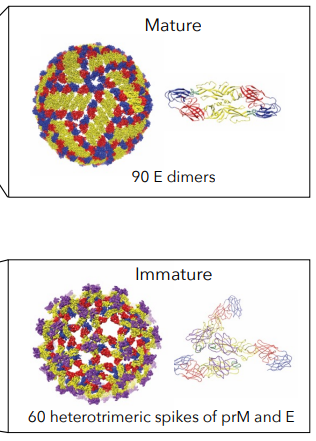
34
New cards
Transmission of Flaviviruses
Vector-borne
* Enzootic cycle: spillover from mosquitoes/birds
* Sylvatic/Urban cycle: spillover from mosquitoes/primates
* Enzootic cycle: spillover from mosquitoes/birds
* Sylvatic/Urban cycle: spillover from mosquitoes/primates

35
New cards
Pathogenesis of Flaviviruses
Febrile w/ Arthralgia (joint stiffness)
* Dengue, Zika
Hemorrhagic (vascular leak, cardiovascular dysfunction)
* Yellow fever, Dengue
Encephalitides (brain inflammation)
* Zika
* Dengue, Zika
Hemorrhagic (vascular leak, cardiovascular dysfunction)
* Yellow fever, Dengue
Encephalitides (brain inflammation)
* Zika
36
New cards
Yellow Fever Vaccine
Attenuated
* Retains capacity to replicate and induce immune response but does NOT cause pathogenesis
Seroconversion
* Single dose provides life-long protection
* Retains capacity to replicate and induce immune response but does NOT cause pathogenesis
Seroconversion
* Single dose provides life-long protection
37
New cards
Dengue Virus
* 4 serotypes derived from primate reservoir
* Transmitted via female mosquitoes (aedes aegypti)
* Transmitted via female mosquitoes (aedes aegypti)
38
New cards
Dengue Pathogenesis
* Most infections asymptomatic
* Sequential infection leads to inappropriate immune response
* Antibody-dependent enhancement
\
Dengue Fever (primary; DENV2)
* Fever, headache, retro-orbital pain, myalgia/arthralgias, fatigue, nausea, cutaneous rash, thrombocytopenia, leukopenia
DHF/DSS Severe Disease (secondary; DENV4)
* Plasma leakage → shock, fluid accumulation in lungs, severe bleeding, organ failure
* Sequential infection leads to inappropriate immune response
* Antibody-dependent enhancement
\
Dengue Fever (primary; DENV2)
* Fever, headache, retro-orbital pain, myalgia/arthralgias, fatigue, nausea, cutaneous rash, thrombocytopenia, leukopenia
DHF/DSS Severe Disease (secondary; DENV4)
* Plasma leakage → shock, fluid accumulation in lungs, severe bleeding, organ failure
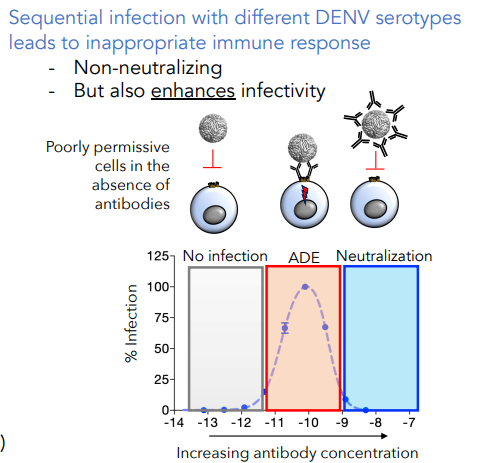
39
New cards
Dengue Vaccine
Dengvaxia
* Live attenuated, multi-valent vaccine (all 4 serotypes)
* the vaccine could increase cases of dengue in children w/o prior exposure (via ADE)
* Live attenuated, multi-valent vaccine (all 4 serotypes)
* the vaccine could increase cases of dengue in children w/o prior exposure (via ADE)
40
New cards
Zika Virus
* Affected naive population
* Cross-reactive w/ dengue so difficult to survey
* Caused by aedes spp. mosquitoes
* Cross-reactive w/ dengue so difficult to survey
* Caused by aedes spp. mosquitoes
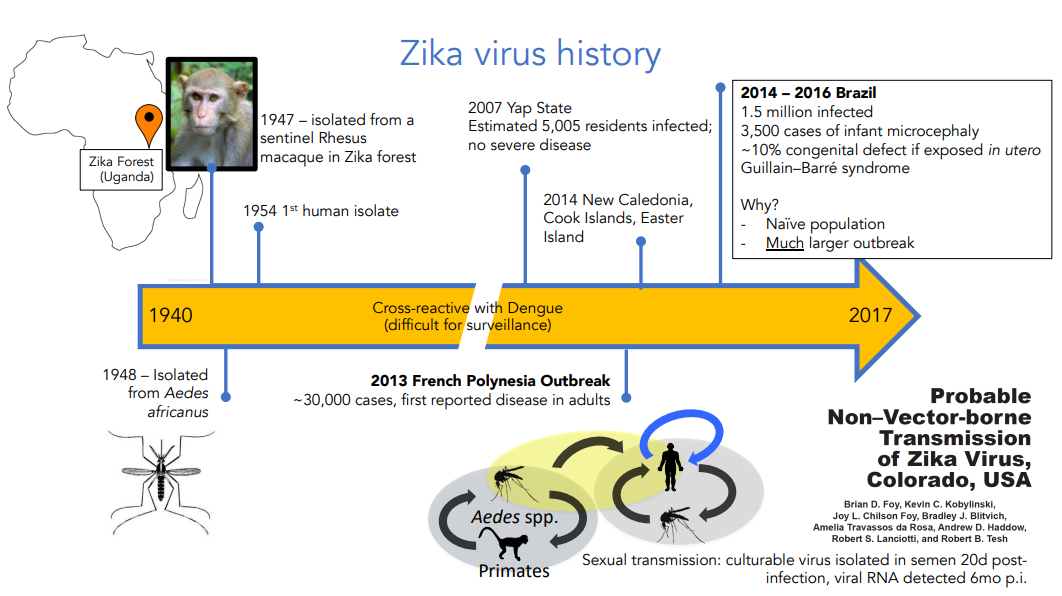
41
New cards
Structure of Coronaviridae
* Helical capsid
* Enveloped
* Enveloped
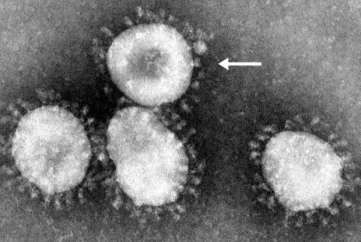
42
New cards
Genome of Coronaviridae
* (+) strand RNA virus
* 30 kb (largest RNA genome virus family)
* Only 7 cause significant human disease
* 2 ORFs (1a: normal protein | 1b: frameshifting)
* ORFs are replicases that encode replication proteins
* 2 viral proteases cleave these into smaller units
* Subgenomic mRNAs make structural/accessory proteins
* S = spike | E = envelope | N = nucleocapsid | M = matrix
* 30 kb (largest RNA genome virus family)
* Only 7 cause significant human disease
* 2 ORFs (1a: normal protein | 1b: frameshifting)
* ORFs are replicases that encode replication proteins
* 2 viral proteases cleave these into smaller units
* Subgenomic mRNAs make structural/accessory proteins
* S = spike | E = envelope | N = nucleocapsid | M = matrix
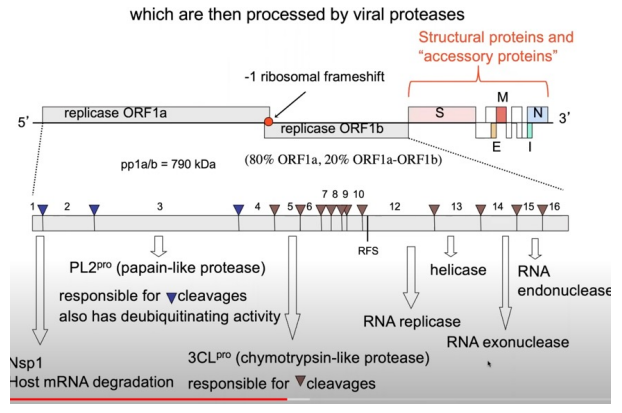
43
New cards
Attachment of Coronaviridae
Receptors
* Sars & HuCoVs: Ace2 | Mers: DPP4
Virus Attachment Proteins
* Spikes contain receptor binding and cleavage domains
* Cleavage releases fusion machinery
* Sars & HuCoVs: Ace2 | Mers: DPP4
Virus Attachment Proteins
* Spikes contain receptor binding and cleavage domains
* Cleavage releases fusion machinery
44
New cards
Entry of Coronaviridae
Fusion at cytoplasmic membrane or after endocytosis
* Membrane fusion allows nucleocapsid to enter cytoplasm
* Viral RNA goes to ER/Golgi for expression/replication
* Membrane fusion allows nucleocapsid to enter cytoplasm
* Viral RNA goes to ER/Golgi for expression/replication
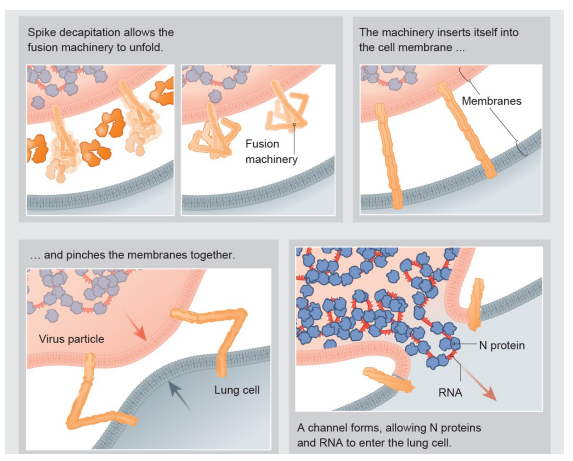
45
New cards
Nested mRNAs
Repeat sequences at the 3’ end of the genome are homologous to 5’ end
* When making the (-) strand, strand jumps and binds to the 5’ repeat and makes an mRNA with the 5’ portion connected to the genes at the 3’ end
* This can occur at each repeat making a series of sub-genomic (-) strands that are made into mRNA since they have the 5’ region of the genome
* When making the (-) strand, strand jumps and binds to the 5’ repeat and makes an mRNA with the 5’ portion connected to the genes at the 3’ end
* This can occur at each repeat making a series of sub-genomic (-) strands that are made into mRNA since they have the 5’ region of the genome
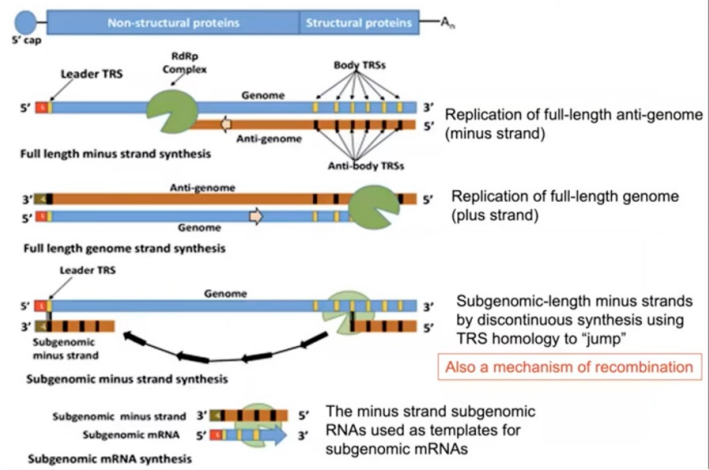
46
New cards
Proofreading in Coronaviridae
correct errors in replication by the RdRp
* without proofreading there would be too many mutations for a species to survive (error catastrophe)
* Coronaviruses break the Eigan paradox
* without proofreading there would be too many mutations for a species to survive (error catastrophe)
* Coronaviruses break the Eigan paradox
47
New cards
Eigan Paradox
to get larger than a certain length, a replicating RNA must have proof-reading but to have proofreading it must be larger than that length so no replicating RNA can do this
48
New cards
Recombination in Coronaviridae
If two coronaviruses infect the same cell, recombination can occur
* facilitated by the strand jumping to make 3’ genes
* one way new strains form
* facilitated by the strand jumping to make 3’ genes
* one way new strains form
49
New cards
Egress in Coronaviridae
Similar to flaviviruses BUT from ER-Golgi
50
New cards
Human Coronavirus
* 4 types cause 20% of common cold cases
* Alpha: 229E & NL63 | Beta: OC43 & HKU1
* Common cold is immunopathogenic and caused by innate immune cytokine response; Also causes upper respiratory disease in nasal area
* Spread through respiratory route
* Very common infection
* Alpha: 229E & NL63 | Beta: OC43 & HKU1
* Common cold is immunopathogenic and caused by innate immune cytokine response; Also causes upper respiratory disease in nasal area
* Spread through respiratory route
* Very common infection
51
New cards
Animal Origin of Human Coronavirus
* 2 human beta-coronaviruses are from bats via llama intermediate
* 2 human alpha-coronaviruses are from rodents via cow intermediate
* 2 human alpha-coronaviruses are from rodents via cow intermediate
52
New cards
Severe Acute Respiratory Syndrome Coronavirus (SARs)
deadly respiratory disease (approx. 10%)
* First cases were animal handlers in exotic meat market
* Palm civet cats & racoon dogs were intermediate hosts
* Horseshow bats were reservoir hosts
* likely came from a recombination event of viruses in bats through the palm civet cat to humans
* Spread from China to other parts of the world
* Spread human to human
* First cases were animal handlers in exotic meat market
* Palm civet cats & racoon dogs were intermediate hosts
* Horseshow bats were reservoir hosts
* likely came from a recombination event of viruses in bats through the palm civet cat to humans
* Spread from China to other parts of the world
* Spread human to human
53
New cards
Why did SARs end quickly?
* Strong measures to limit spread in East Asia (no travel, heavy quarantine, temp monitors)
* R0 value was relatively low outside of super spreaders
* It is not common in bats or intermediate species (has not been isolated in bats or other species since)
* R0 value was relatively low outside of super spreaders
* It is not common in bats or intermediate species (has not been isolated in bats or other species since)
54
New cards
Middle East Respiratory Syndrome (MERS)
* Spread in the middle east from camels to humans
* Camels are the intermediate host for humans
* Bats are the reservoir
* Not closely related to SARS-CoV but closely related to bat Coronavirus
* 34% death rate!
* Does NOT spread from person to person easily
* Limited human transmission is common for spillover events
* Camels are the intermediate host for humans
* Bats are the reservoir
* Not closely related to SARS-CoV but closely related to bat Coronavirus
* 34% death rate!
* Does NOT spread from person to person easily
* Limited human transmission is common for spillover events
55
New cards
SARS-CoV-2
* natural zoonotic infection of humans from an intermediate host
* lab leak is not likely; lab engineered virus not possible
* Respiratory spread via saliva (fomite not common)
* Upper respiratory infection, lungs, intestines, brain
* Intestines less likely to be infectious virus so less likely to be a point of spread to next host
* lab leak is not likely; lab engineered virus not possible
* Respiratory spread via saliva (fomite not common)
* Upper respiratory infection, lungs, intestines, brain
* Intestines less likely to be infectious virus so less likely to be a point of spread to next host
56
New cards
COVID 19
* SARS-CoV-2 is the virus, COVID-19 is the disease
* Predominantly an upper respiratory disease
* Many infections are asymptomatic
* Fever, Dry cough, Shortness of breath, Body ache, fatigue, Loss of smell and taste, diarrhea
* Advanced disease symptoms: Immune cells infiltrate the lungs due to break down of endothelial and epithelial barriers; Fluid starts to fill lungs limiting function and requiring ventilation; Blood can also enter the lungs
* Cause of death is loss of lung function and other effects
* Predominantly an upper respiratory disease
* Many infections are asymptomatic
* Fever, Dry cough, Shortness of breath, Body ache, fatigue, Loss of smell and taste, diarrhea
* Advanced disease symptoms: Immune cells infiltrate the lungs due to break down of endothelial and epithelial barriers; Fluid starts to fill lungs limiting function and requiring ventilation; Blood can also enter the lungs
* Cause of death is loss of lung function and other effects
57
New cards
Long-term effects of COVID
* Long-term activation of immune system due to remnants of the virus
* Autoantibodies induced by the virus that remain and attack cells
* Chronic inflammation
* Shortness of breath from lung damage
* Circulatory system issues
* Trouble with physical activity
* Nerve fiber damage and chronic inflammation
* Less oxygen in blood
* Micro-clots of blood can damage small arteries
* Brain
* Cognitive impairment
* Microglia overactivation
* Autoantibodies induced by the virus that remain and attack cells
* Chronic inflammation
* Shortness of breath from lung damage
* Circulatory system issues
* Trouble with physical activity
* Nerve fiber damage and chronic inflammation
* Less oxygen in blood
* Micro-clots of blood can damage small arteries
* Brain
* Cognitive impairment
* Microglia overactivation
58
New cards
SARS-CoV-2 Vaccines
* Inactivated: did not work well
* Live attenuated
* Subunit: attenuated adenovirus containing spike protein (1 dose)
* RNA: cell makes spike protein from mRNA and antibodies attack (2 doses)
* Live attenuated
* Subunit: attenuated adenovirus containing spike protein (1 dose)
* RNA: cell makes spike protein from mRNA and antibodies attack (2 doses)
59
New cards
Sars-CoV-2 Antivirals
* Remdesivir (Veklury)
* Viral Polymerase (RdRp) inhibitor; Intravenous therapy
* Paxlovid
* Combination of two drugs, an antiviral and a drug that increases bioavailability of the antiviral used in a 5 day treatment for high risk patients; inhibits viral protease to inhibit mature virus production
* Lagervrio (molnupiravir)
* polymerase inhibitor
* Immune modulators
* Block parts of the innate immune system to slow disease
* Antibody therapy
* Limits disease; IV injections of neutralizing antibodies
* Viral Polymerase (RdRp) inhibitor; Intravenous therapy
* Paxlovid
* Combination of two drugs, an antiviral and a drug that increases bioavailability of the antiviral used in a 5 day treatment for high risk patients; inhibits viral protease to inhibit mature virus production
* Lagervrio (molnupiravir)
* polymerase inhibitor
* Immune modulators
* Block parts of the innate immune system to slow disease
* Antibody therapy
* Limits disease; IV injections of neutralizing antibodies
60
New cards
Lab tests for SARS-CoV-2 infection
* PCR test: Most sensitive
* Tests for the presence of viral RNA; can test positive after you are infectious since it is highly sensitive
* Rapid antigen test: A little less sensitive but possibly more accurate for ongoing infections
* Tests for the presence of SARS-CoV-2 proteins
* Antibody test
* Test your blood for the presence of antibodies to SARS-CoV-2
* determines if you have ever been infected with the virus but cannot differentiate how recent
* Tests for the presence of viral RNA; can test positive after you are infectious since it is highly sensitive
* Rapid antigen test: A little less sensitive but possibly more accurate for ongoing infections
* Tests for the presence of SARS-CoV-2 proteins
* Antibody test
* Test your blood for the presence of antibodies to SARS-CoV-2
* determines if you have ever been infected with the virus but cannot differentiate how recent
61
New cards
Structure of Retroviridae
Icosahedral & Enveloped
62
New cards
Genome of Retroviridae
Reverse transcription from RNA to DNA; (+) ssRNA
* Diploid: 2 genomes are packaged
* Diploid: 2 genomes are packaged
63
New cards
Simple Retroviruses
* Identified in birds, rodents, and other animals (ALV, muLV)
* Express gag, pol, env
* Cannot get through nuclear membrane; Require cellular division to enter nucleus
* NO simple human retroviruses
* Express gag, pol, env
* Cannot get through nuclear membrane; Require cellular division to enter nucleus
* NO simple human retroviruses
64
New cards
Complex Retroviruses
* Identified in primates (HIV, SIV, HTLV-1/2, Simian foamy virus)
* Express gag, pol, env BUT w/ accessory proteins
* Able to trasnverse nuclear membrane in a non-dividing cell
* Express gag, pol, env BUT w/ accessory proteins
* Able to trasnverse nuclear membrane in a non-dividing cell
65
New cards
Acquired Immuno-Deficiency Syndrome (AIDS)
severe decline in CD4+ T-cells → declining immune system
* Spread via blood supply
* AIDS is a collection of diseases due to immunosuppression; AIDS patients die of many different diseases that they can no longer fight off
* Spread via blood supply
* AIDS is a collection of diseases due to immunosuppression; AIDS patients die of many different diseases that they can no longer fight off
66
New cards
Human immunodeficiency virus (HIV)
a retrovirus in the T-cells of AIDS patients
* HIV as the causative agent of AIDS
* HIV-1 most closely related to chimpanzee SIV; HIV-2 rare outside of west Africa b/c less transmissible between humans
* HIV is spread by blood and sexual secretions (and breast milk)
* can be vertically transmitted to newborns; In utero, during birth and it can be secreted in breast milk
* HIV is **NOT** transmitted by saliva, mosquitos, fecal-oral
* HIV as the causative agent of AIDS
* HIV-1 most closely related to chimpanzee SIV; HIV-2 rare outside of west Africa b/c less transmissible between humans
* HIV is spread by blood and sexual secretions (and breast milk)
* can be vertically transmitted to newborns; In utero, during birth and it can be secreted in breast milk
* HIV is **NOT** transmitted by saliva, mosquitos, fecal-oral
67
New cards
Entry of HIV
* Part of the Env protein (gp120) initially binds to CD4 and conformational change allos gp120 to bind to a co-receptor and lead to exposure of fusion peptide on gp41 (integral membrane protein)
* HIV-1 transmitted between humans initially uses CCR-5 as a co-receptor prior to fusion
* Present on activated T-cells and macrophages
* Transmission to a new host is almost always the CCR-5
* Mutations lead some viruses in the body to switch to using CXCR-4 as a co-receptor
* Present on Naïve (resting) T-cells; happens later during the course of infection of a person
* HIV-1 transmitted between humans initially uses CCR-5 as a co-receptor prior to fusion
* Present on activated T-cells and macrophages
* Transmission to a new host is almost always the CCR-5
* Mutations lead some viruses in the body to switch to using CXCR-4 as a co-receptor
* Present on Naïve (resting) T-cells; happens later during the course of infection of a person

68
New cards
CCR-5 and CXCR-4 Co-Receptors of HIV
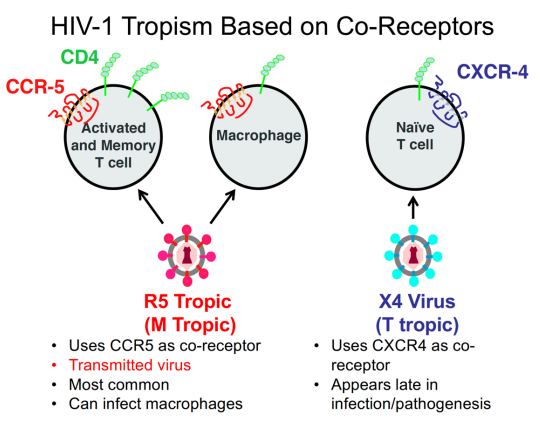
69
New cards
Retroviral polymerase (Pol)
* Makes complementary DNA strand from RNA template
* reverse transcription
* Degrades the RNA from the DNA/RNA hybrid
* RNaseH activity
* Makes complementary DNA strand from DNA template
* DNA polymerase
* Inserts the DNA into a host chromosome
* Integrase; Integration site is somewhat random in the genome though active areas
\
* For HIV the protease that cleaves GAG to make mature virion is part of pol
* Because HIV uses host transcriptional machinery, pol is only needed for packaging for use upon entry into the next cell
* reverse transcription
* Degrades the RNA from the DNA/RNA hybrid
* RNaseH activity
* Makes complementary DNA strand from DNA template
* DNA polymerase
* Inserts the DNA into a host chromosome
* Integrase; Integration site is somewhat random in the genome though active areas
\
* For HIV the protease that cleaves GAG to make mature virion is part of pol
* Because HIV uses host transcriptional machinery, pol is only needed for packaging for use upon entry into the next cell
70
New cards
Reverse transcriptase
1. Reverse transcription is primed by tRNAs in open capsid in the cytoplasm
2. RT initiates DNA synthesis towards the end so after 100 bases it switches to the other end of the template to create terminal repeats (left is shorter)
3. (+) DNA strand is then templated (again complicated) but requires DdDp; dsDNA has both LTRs
4. DNA is then transported to the nucleus where the integrase incorporates in into the host DNA

71
New cards
Retrovirus Splicing
* Full length transcript encodes two open reading frames
* GAG
* GAG-Pol (GAG-Pol is made by a -1 ribosomal frameshift, bypassing the GAG stop codon allowing a longer protein to be made
* There is less GAG-Pol than GAG alone
* Envelope is made from a spliced mRNA that splices out the GAG-Pol
* For complex retroviruses there complex splicing for many mRNAs, one for each accessory protein
* GAG
* GAG-Pol (GAG-Pol is made by a -1 ribosomal frameshift, bypassing the GAG stop codon allowing a longer protein to be made
* There is less GAG-Pol than GAG alone
* Envelope is made from a spliced mRNA that splices out the GAG-Pol
* For complex retroviruses there complex splicing for many mRNAs, one for each accessory protein
72
New cards
Tat
unique to HIV
* binds to a specific sequence (Tar) at the 5’ end of the newly transcribed viral RNA made by the cell; stabilizes the mRNA allowing more to be made
* binds to a specific sequence (Tar) at the 5’ end of the newly transcribed viral RNA made by the cell; stabilizes the mRNA allowing more to be made
73
New cards
Rev
unique to HIV
* binds to viral mRNAs and promotes the transit of unspliced viral mRNA to the cytoplasm
* most of the viral mRNAs that make it out of the nucleus to be translated are the spliced messages which allow expression of rev
* Rev then transits to the nucleus where it binds to the unspliced viral mRNA through a specific sequence and helps it transit to the cytoplasm where it is translated (Gag and Gag-Pol) which allows higher expression of gag and gag-pol
* binds to viral mRNAs and promotes the transit of unspliced viral mRNA to the cytoplasm
* most of the viral mRNAs that make it out of the nucleus to be translated are the spliced messages which allow expression of rev
* Rev then transits to the nucleus where it binds to the unspliced viral mRNA through a specific sequence and helps it transit to the cytoplasm where it is translated (Gag and Gag-Pol) which allows higher expression of gag and gag-pol
74
New cards
Assembly & Egress of Retroviruses
* Gag and a little bit of Gag-Pol transits to cytoplasmic membrane where Env is present
* 2 RNA genomes also transit
* Probably with Gag
* Gag begins to bud with env outside and RNA inside
* Once it is released the protease cleaves the Gag into subunits
* MA matrix
* CA Capsid
* NC Nucleocapsid
* This step is maturation step, prior to cleavage particles are not infectious
* 2 RNA genomes also transit
* Probably with Gag
* Gag begins to bud with env outside and RNA inside
* Once it is released the protease cleaves the Gag into subunits
* MA matrix
* CA Capsid
* NC Nucleocapsid
* This step is maturation step, prior to cleavage particles are not infectious
75
New cards
Chronic Infection of HIV
* Viremia (virus in the blood stream) peaks in the first few weeks
* The immune system limits the viremia but does not eliminate
* A “set point” is reached where there is a constant lower level of viremia
* After years, the virus starts to replicate at higher levels killing off the CD4+ T-cells
* When the CD4+ T-cell falls very low, clinical AIDS occurs
* How fast you go from normal chronic infection to AIDS depend primarily on the level of set point
* High set point: rapid progressors
* Low set point: long term non- progressors
* The immune system limits the viremia but does not eliminate
* A “set point” is reached where there is a constant lower level of viremia
* After years, the virus starts to replicate at higher levels killing off the CD4+ T-cells
* When the CD4+ T-cell falls very low, clinical AIDS occurs
* How fast you go from normal chronic infection to AIDS depend primarily on the level of set point
* High set point: rapid progressors
* Low set point: long term non- progressors

76
New cards
Quasi-species and immune avoidance (HIV)
The reverse transcription step is not high fidelity and there is no proofreading for this step. Therefore, there are mutations each replication cycle
* At set-point the body is still making billions or trillions of viral particles a day so there is a high level of quasi-species which allows the virus to avoid complete shutdown by the immune system
* At set-point the body is still making billions or trillions of viral particles a day so there is a high level of quasi-species which allows the virus to avoid complete shutdown by the immune system
77
New cards
Latent State (HIV)
latent state in some non-dividing cells
* The LTR is not transcribed by the host in these cells (missing factors that bind the promoter)
* However, since the virus is integrated it is permanently part of the genetic material
* The LTR can become active later and the virus can ”reactivate” and start producing virus particles again
* The LTR is not transcribed by the host in these cells (missing factors that bind the promoter)
* However, since the virus is integrated it is permanently part of the genetic material
* The LTR can become active later and the virus can ”reactivate” and start producing virus particles again
78
New cards
Antiretroviral Therapy (ART)
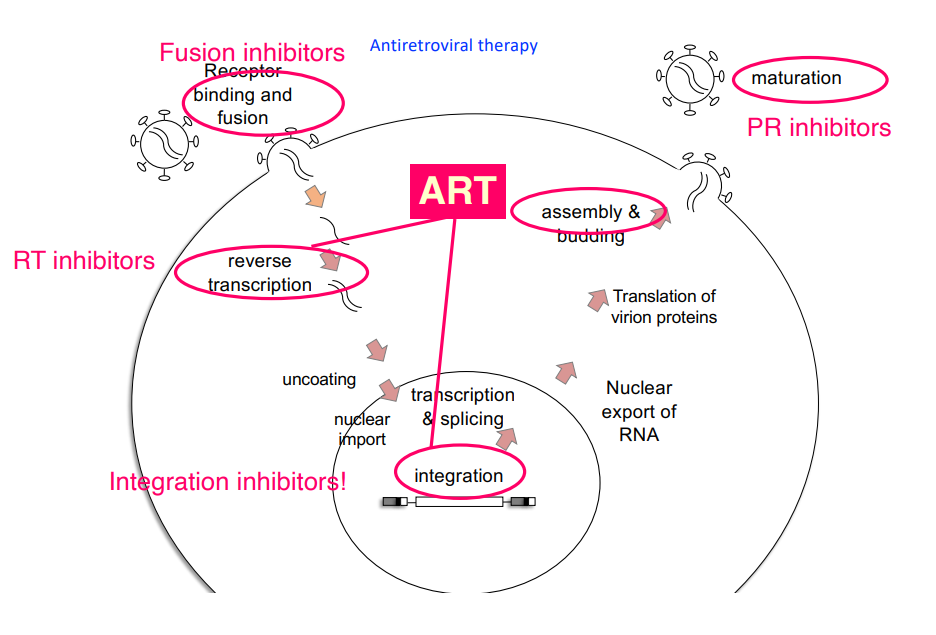
79
New cards
Why don’t we have a vaccine for HIV?
* Quasi-species make the virus everchanging inside the body
* HIV envelope (gp120 and gp41)..
* is very sparse on the surface so relatively few targets
* is in closed position that is altered upon CD4 binding so many viral epitopes are hidden (important because of quasispecies possibilities)
* is heavily glycosylyated
* HIV envelope (gp120 and gp41)..
* is very sparse on the surface so relatively few targets
* is in closed position that is altered upon CD4 binding so many viral epitopes are hidden (important because of quasispecies possibilities)
* is heavily glycosylyated
80
New cards
Structure of Poxviridae
Largest of human viruses (300nM); Complex brick like structure
* Only 2 are obligate human pathogens (variola and molluscum contagiosum virus)
* Only 2 are obligate human pathogens (variola and molluscum contagiosum virus)
81
New cards
Genome of Poxviridae
linear dsDNA w/ fused ends
* 150-300 kbp
ONLY DNA virus to replicate in cytoplasm
* must encode its own RNA polymerase and accessory proteins
* 150-300 kbp
ONLY DNA virus to replicate in cytoplasm
* must encode its own RNA polymerase and accessory proteins
82
New cards
Replication of Poxviridae
* Binds receptors and enters by membrane fusion
* The double stranded DNA is nicked and the polymerase templates toward the fused end
* The ends then separate to form the loops and the polymerase templates both sides of the DNA until it gets to the other fused end
* Effectively a giant replication fork
* This forms concatamers that are then resolved
* Remains in the cytoplasm despite being a DNA virus
* The double stranded DNA is nicked and the polymerase templates toward the fused end
* The ends then separate to form the loops and the polymerase templates both sides of the DNA until it gets to the other fused end
* Effectively a giant replication fork
* This forms concatamers that are then resolved
* Remains in the cytoplasm despite being a DNA virus
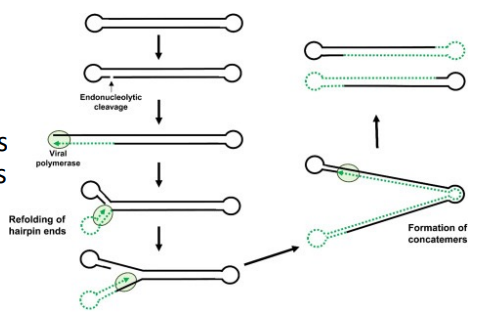
83
New cards
Entry of Poxvirus
* Receptors are not well identified for most poxviruses
* Initial binding is likely to glycosaminoglycans
* However, there are two types of viral particles, enveloped (MV) and double enveloped (EV), that have different viral proteins
* Viruses fuse at the cytoplasmic membrane or from endocytic vesicles
* Double enveloped lose the second envelope to gain access to fusion receptors
* Myxomavirus (a rabbit poxvirus) requires CCR5 or other chemokine receptors
* A small % of the human population cannot be infected by HIV because they contain a CCR5 mutant; __**If**__ Variola virus also uses CCR5 this would provide the selection for mutants of CCR5
* Membrane of poxviruses fuse with the cytoplasmic membrane
* Can also fuse from endosome
* Initial binding is likely to glycosaminoglycans
* However, there are two types of viral particles, enveloped (MV) and double enveloped (EV), that have different viral proteins
* Viruses fuse at the cytoplasmic membrane or from endocytic vesicles
* Double enveloped lose the second envelope to gain access to fusion receptors
* Myxomavirus (a rabbit poxvirus) requires CCR5 or other chemokine receptors
* A small % of the human population cannot be infected by HIV because they contain a CCR5 mutant; __**If**__ Variola virus also uses CCR5 this would provide the selection for mutants of CCR5
* Membrane of poxviruses fuse with the cytoplasmic membrane
* Can also fuse from endosome
84
New cards
Transcription of Poxvirus
* Because they replicate in the cytoplasm, in addition to a DNA dependent DNA polymerase (DdDp), Poxviruses also encode a DNA dependent RNA polymerase (DdRp)
* Therefore, poxviruses make their own mRNA
* They also encode capping and 3’ polyadenylation enzymes
* Poxviruses also encode a 5’ polyadenylation signal
* PolyA leaders allow capped and uncapped messages to be translated
* Therefore, poxviruses make their own mRNA
* They also encode capping and 3’ polyadenylation enzymes
* Poxviruses also encode a 5’ polyadenylation signal
* PolyA leaders allow capped and uncapped messages to be translated
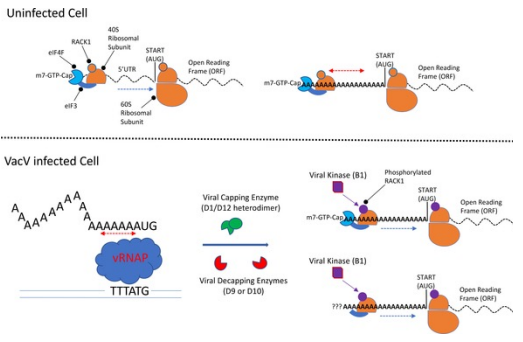
85
New cards
Early Genes of Poxvirus
* All the machinery necessary to make early genes are present in the core of the virus particle so early genes are transcribed immediately upon entry before uncoating
* Encode all of the polymerases allowing genome replication and further transcription of viral mRNA
* Encode proteins that are secreted (growth factors and cytokine inhibitors) and alter the cells around an infected cell
* Encode all of the polymerases allowing genome replication and further transcription of viral mRNA
* Encode proteins that are secreted (growth factors and cytokine inhibitors) and alter the cells around an infected cell
86
New cards
Intermediate Genes of Poxvirus
* Allow late gene expression
* Encode intracellular modulators (inhibition of apoptosis, host cell signaling etc…)
* Encode intracellular modulators (inhibition of apoptosis, host cell signaling etc…)
87
New cards
Late Genes of Poxvirus
* Structure and assembly proteins (capsid proteins, surface glycoproteins etc…)
88
New cards
Egress of Poxvirus
* Mature particles are made in the cytoplasm (MV) in virus factories
* These can exit by cell lysis and infect other cells
* Like naked viruses but with an envelope
* Mature particles can also get wrapped in a second membrane in the golgi (Extracellular virus EV)
* The EV particles then transit out of the cell
* Similar to other enveloped viruses
* However, these end up with a double membrane
* EV particles can be pushed into the next cell on actin pedestals that just out of the cell
* These can exit by cell lysis and infect other cells
* Like naked viruses but with an envelope
* Mature particles can also get wrapped in a second membrane in the golgi (Extracellular virus EV)
* The EV particles then transit out of the cell
* Similar to other enveloped viruses
* However, these end up with a double membrane
* EV particles can be pushed into the next cell on actin pedestals that just out of the cell
89
New cards
Animal poxviruses
* Insect & Chordates (main subfamilies)
* Many genera in chordates
* Poxviruses found in birds, rabbits
* Orthopox contains variola, cowpox, and vaccinia
* Many animal poxviruses do not productively infect humans
* Many genera in chordates
* Poxviruses found in birds, rabbits
* Orthopox contains variola, cowpox, and vaccinia
* Many animal poxviruses do not productively infect humans
90
New cards
Australian rabbit control and myxomavirus
Australian government introduce myxomavirus since rabbits had no predator
* The virus killed 99% of the rabbits and there was a great recovery of grass and farm animals
* eventually, the rabbits who lived had resistance to the virus and re-populated the country
* Australia then released rabbit hemorrhagic fever viruses (caliciviruses) and the rabbit population decreased
* The virus killed 99% of the rabbits and there was a great recovery of grass and farm animals
* eventually, the rabbits who lived had resistance to the virus and re-populated the country
* Australia then released rabbit hemorrhagic fever viruses (caliciviruses) and the rabbit population decreased
91
New cards
Human poxviruses
* Moluscum Congiosum virus & Variola virus
* Mpox, ORF, and Cowpox can also infect humans
* Mpox, ORF, and Cowpox can also infect humans
92
New cards
Molluscum Contagiosum
Mild skin disease effecting outer epithelium; When untreated they usually disappear after 6-12 months
* Causes small (about .5 cm) white or pink raised bumps occuring anywhere on the body
* Spread skin to skin (direct contact or by towels)
* Immunosuppressed patients can develop larger growths
* can be treated like warts and removed with acid or burning the skin layers but they are usually untreated
* Causes small (about .5 cm) white or pink raised bumps occuring anywhere on the body
* Spread skin to skin (direct contact or by towels)
* Immunosuppressed patients can develop larger growths
* can be treated like warts and removed with acid or burning the skin layers but they are usually untreated
93
New cards
Variola Virus
etiologic agent of Small Pox
* 186 kbp encoding over 200 genes
* Major: 30% fatality | Minor: 1-2% fatality
* 186 kbp encoding over 200 genes
* Major: 30% fatality | Minor: 1-2% fatality
94
New cards
Small Pox Fatality
* In 18th century smallpox accounted for around 10% of all deaths and 30% of deaths in children
* In the 20th century Small Pox killed approximately 300 million people
* In the 20th century Small Pox killed approximately 300 million people
95
New cards
Small Pox Elimination
Vaccine is a homologous virus from another animal
* approach works because variola and vaccinia share a number of antigenic determinants
* Variola Virus officially eliminated from the world in 1980
* Vaccination was stopped in the U.S. in 1982
* Live virus now stored in only two places (CDC and in Russia)
* approach works because variola and vaccinia share a number of antigenic determinants
* Variola Virus officially eliminated from the world in 1980
* Vaccination was stopped in the U.S. in 1982
* Live virus now stored in only two places (CDC and in Russia)
96
New cards
Antigenic determinants
many proteins have identical or similar regions that antibodies are made to
97
New cards
Pathogenesis of Variola Virus
* Virus was inhaled and replicated in the upper respiratory tract
* Dissemination was through viremia
* Skin was then infected during secondary viremia
* Pox arose all over the body often leaving scar marks
* Less efficient spread could be from dried virus (for example on blankets)
* Dissemination was through viremia
* Skin was then infected during secondary viremia
* Pox arose all over the body often leaving scar marks
* Less efficient spread could be from dried virus (for example on blankets)
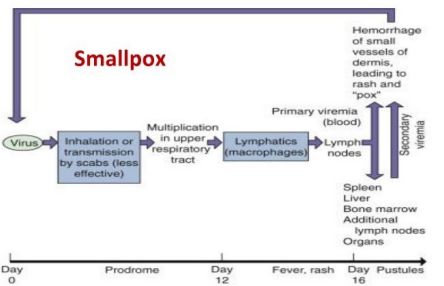
98
New cards
Variolation
Original vaccination of variola virus in 15th-18th centuries
* People were inoculated with scabs from small pox patients to form protection
* in some percentage of cases there was too much live virus and the inoculated patient died of small pox
* People were inoculated with scabs from small pox patients to form protection
* in some percentage of cases there was too much live virus and the inoculated patient died of small pox
99
New cards
Variola Virus Vaccine
* Cowpox as vaccine in the late 1700ʼs
* people who previously had cowpox did not get small pox
* Vaccinia Virus
* most like horsepox virus
* used to eliminate small pox from the world
* rapid series of skin pricks with needles dipped in infectious virus (classic scar)
* 1 in 1 million can die due to vaccine complications; Major side effects: Large sores, Heart problems
* People with eczema or atopic dermatitis should not be vaccinated as they can get life-threatening pox all over body
* Attenuated vaccine
* MVA (used for variola and mpox)
* made by passaging Vaccinia virus in Chicken egg membranes over 500 times; After 500 passages it no longer replicates in human cells
* people who previously had cowpox did not get small pox
* Vaccinia Virus
* most like horsepox virus
* used to eliminate small pox from the world
* rapid series of skin pricks with needles dipped in infectious virus (classic scar)
* 1 in 1 million can die due to vaccine complications; Major side effects: Large sores, Heart problems
* People with eczema or atopic dermatitis should not be vaccinated as they can get life-threatening pox all over body
* Attenuated vaccine
* MVA (used for variola and mpox)
* made by passaging Vaccinia virus in Chicken egg membranes over 500 times; After 500 passages it no longer replicates in human cells
100
New cards
What is necessary for eradication of a virus?
* No animal reservoir
* Minimal serotypes that cause disease
* No persistence
* Causes acute recognizable disease
* Effective vaccine to prevent spread
* World wide will to eliminate it (and money)
* Minimal serotypes that cause disease
* No persistence
* Causes acute recognizable disease
* Effective vaccine to prevent spread
* World wide will to eliminate it (and money)
